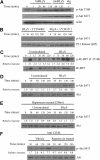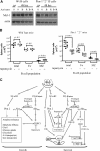Multiple signaling pathways promote B lymphocyte stimulator dependent B-cell growth and survival
- PMID: 17942753
- PMCID: PMC2200845
- DOI: 10.1182/blood-2007-03-077222
Multiple signaling pathways promote B lymphocyte stimulator dependent B-cell growth and survival
Abstract
We investigated the mechanism by which B lymphocyte stimulator (BLyS)/BAFF, a tumor necrosis factor superfamily ligand, promotes B-cell survival and resistance to atrophy. BLyS stimulation activates 2 independent signaling pathways, Akt/mTOR and Pim 2, associated with cell growth and survival. BLyS blocks the cell volume loss (atrophy) that freshly isolated B cells normally undergo when maintained in vitro while concurrently increasing glycolytic activity and overall metabolism. This atrophy resistance requires Akt/mTOR. We used a genetic approach to resolve the contributions of Akt/mTOR and Pim kinase pathways to BLyS-mediated survival. Pim 2-deficient B cells are readily protected from death by BLyS stimulation, but this protection is completely abrogated by treatment with the mTOR inhibitor rapamycin. Furthermore, rapamycin treatment in vivo significantly reduces both follicular and marginal zone B cells in Pim-deficient but not healthy hosts. BLyS-dependent survival requires the antiapoptotic protein Mcl-1. Mcl-1 protein levels rise and fall in response to BLyS addition and withdrawal, respectively, and conditional deletion of the Mcl-1 gene renders B cells refractory to BLyS-mediated protection. Because BlyS is required for the normal homeostasis of all B cells, these data suggest a therapeutic strategy simultaneously inhibiting mTOR and Pim 2 could target pathogenic B cells.
Figures







Similar articles
-
Akt up-regulation increases resistance to microtubule-directed chemotherapeutic agents through mammalian target of rapamycin.Mol Cancer Ther. 2004 Dec;3(12):1605-13. Mol Cancer Ther. 2004. PMID: 15634654
-
B cells expressing Bcl-2 and a signaling-impaired BAFF-specific receptor fail to mature and are deficient in the formation of lymphoid follicles and germinal centers.J Immunol. 2004 Nov 15;173(10):6179-88. doi: 10.4049/jimmunol.173.10.6179. J Immunol. 2004. PMID: 15528355
-
Shared signaling networks active in B cells isolated from genetically distinct mouse models of lupus.J Clin Invest. 2007 Aug;117(8):2186-96. doi: 10.1172/JCI30398. J Clin Invest. 2007. PMID: 17641780 Free PMC article.
-
BLyS and B cell homeostasis.Semin Immunol. 2006 Oct;18(5):318-26. doi: 10.1016/j.smim.2006.06.001. Epub 2006 Aug 22. Semin Immunol. 2006. PMID: 16931037 Review.
-
New roles for the BLyS/BAFF family in antigen-experienced B cell niches.Cytokine Growth Factor Rev. 2014 Apr;25(2):107-13. doi: 10.1016/j.cytogfr.2014.01.001. Epub 2014 Jan 10. Cytokine Growth Factor Rev. 2014. PMID: 24507939 Free PMC article. Review.
Cited by
-
Antigen-affinity controls pre-germinal center B cell selection by promoting Mcl-1 induction through BAFF receptor signaling.Sci Rep. 2016 Oct 20;6:35673. doi: 10.1038/srep35673. Sci Rep. 2016. PMID: 27762293 Free PMC article.
-
Interplay of Murine Gammaherpesvirus 68 with NF-kappaB Signaling of the Host.Front Microbiol. 2016 Aug 17;7:1202. doi: 10.3389/fmicb.2016.01202. eCollection 2016. Front Microbiol. 2016. PMID: 27582728 Free PMC article. Review.
-
The PI3K pathway in B cell metabolism.Crit Rev Biochem Mol Biol. 2016 Sep;51(5):359-378. doi: 10.1080/10409238.2016.1215288. Epub 2016 Aug 5. Crit Rev Biochem Mol Biol. 2016. PMID: 27494162 Free PMC article. Review.
-
Human BLyS facilitates engraftment of human PBL derived B cells in immunodeficient mice.PLoS One. 2008 Sep 11;3(9):e3192. doi: 10.1371/journal.pone.0003192. PLoS One. 2008. PMID: 18784835 Free PMC article.
-
An overview of pim kinase as a target in multiple myeloma.Cancer Med. 2023 May;12(10):11746-11759. doi: 10.1002/cam4.5797. Epub 2023 May 10. Cancer Med. 2023. PMID: 37162273 Free PMC article. Review.
References
-
- Plas DR, Rathmell JC, Thompson CB. Homeostatic control of lymphocyte survival: potential origins and implications. Nat Immunol. 2002;3:515–521. - PubMed
-
- Bodmer JL, Schneider P, Tschopp J. The molecular architecture of the TNF superfamily. Trends Biochem Sci. 2002;27:19–26. - PubMed
-
- Rolink AG, Melchers F. BAFFled B cells survive and thrive: roles of BAFF in B-cell development. Curr Opin Immunol. 2002;14:266–275. - PubMed
Publication types
MeSH terms
Substances
Grants and funding
LinkOut - more resources
Full Text Sources
Other Literature Sources
Molecular Biology Databases
Miscellaneous

